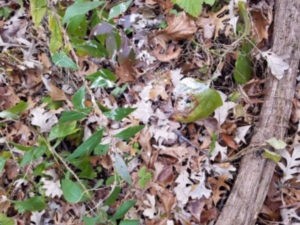by Eileen Sutter, Volunteer Steward at Watersmeet Forest Preserve
One sign of the presence of owls in our woods is whitewash, splatters of thick chalky paste on the ground and on tree branches found around owl roosting spots. Owls typically have night time and day time roosting spots; the night time spot is likely to be near good hunting grounds in the territory, while the day time spot is chosen for its seclusion and cover from predators and pesky crows. Owl white wash is produced by the kidneys, and is the equivalent of urine in mammals. Mammals excrete waste as urea dissolved in urine, but owls excrete urea as uric acid, which has a low solubility in water, so it forms a thick white paste. Owls also produce owl pellets, the accumulation of indigestable material like hair and bones from the food they eat. These pellets are stored in the owl’s gizzard and regurgiated once or twice a day, often under their day time and night time roosts. Regurgitation clears the digestive tract and releases the pressure of the gizzard on the esophagus, allowing the owl to eat again. The presence of owl pellets can guide you to the owl’s roosting spot. It’s a piece of great luck to see an owl in the woods, because of their camouflage, but carefully checking the area where you find signs of an owl like whitewash or pellets can increase your odds of a sighting.
Photo by Eileen Sutter


